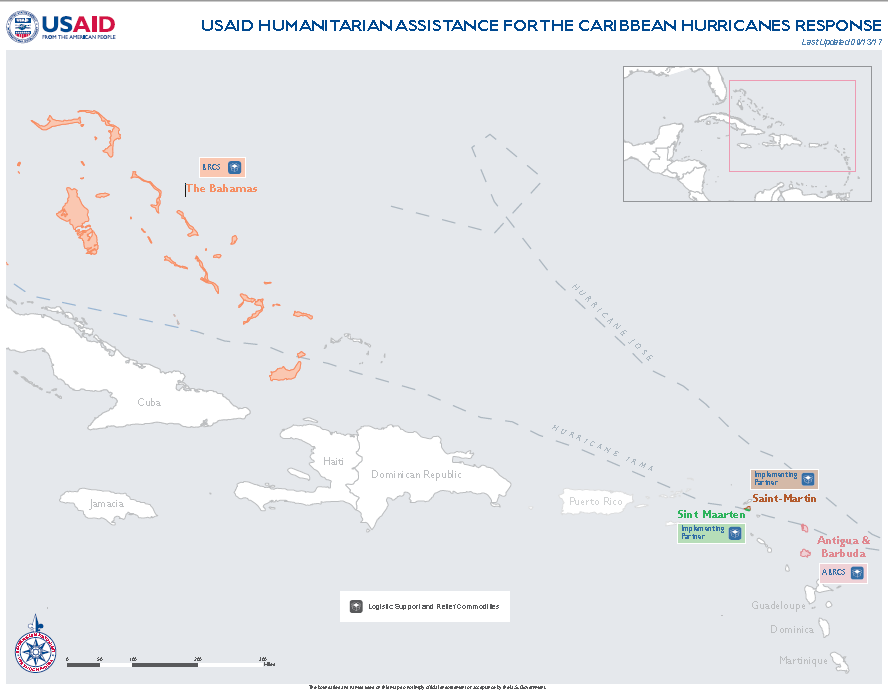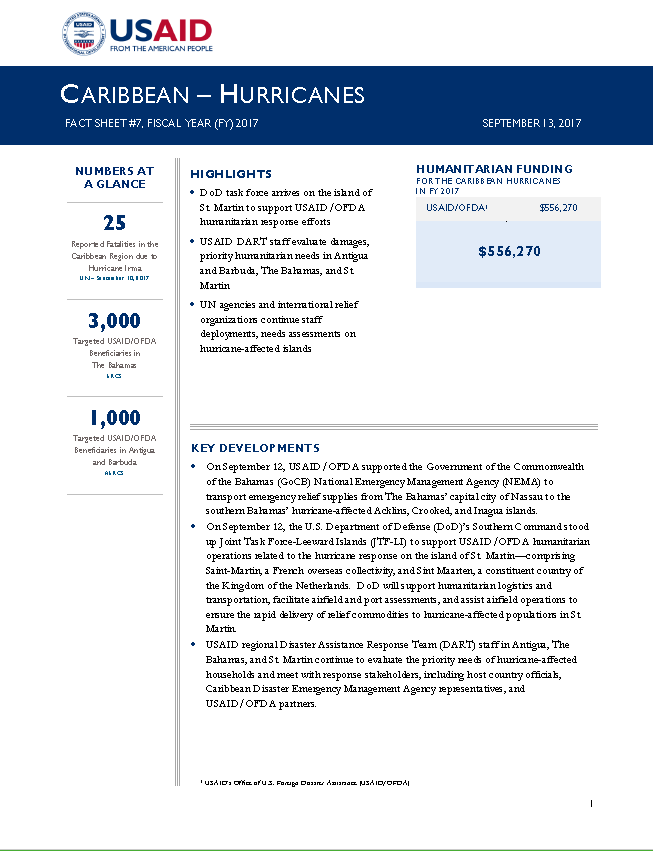September 13, 2017
Highlights
- DoD task force arrives on the island of St. Martin to support USAID/OFDA humanitarian response efforts.
- USAID DART staff evaluate damages, priority humanitarian needs in Antigua and Barbuda, The Bahamas, and St. Martin.
- UN agencies and international relief organizations continue staff deployments, needs assessments on hurricane-affected islands.
Key Developments
On September 12, USAID/OFDA supported the Government of the Commonwealth of the Bahamas (GoCB) National Emergency Management Agency (NEMA) to transport emergency relief supplies from The Bahamas’ capital city of Nassau to the southern Bahamas’ hurricane-affected Acklins, Crooked, and Inagua islands.
On September 12, the U.S. Department of Defense (DoD)’s Southern Command stood up Joint Task Force-Leeward Islands (JTF-LI) to support USAID/OFDA humanitarian operations related to the hurricane response on the island of St. Martin—comprising Saint-Martin, a French overseas collectivity, and Sint Maarten, a constituent country of the Kingdom of the Netherlands. DoD will support humanitarian logistics and transportation, facilitate airfield and port assessments, and assist airfield operations to ensure the rapid delivery of relief commodities to hurricane-affected populations in St. Martin.
USAID regional Disaster Assistance Response Team (DART) staff in Antigua, The Bahamas, and St. Martin continue to evaluate the priority needs of hurricane-affected households and meet with response stakeholders, including host country officials, Caribbean Disaster Emergency Management Agency representatives, and USAID/OFDA partners.
Caribbean Hurricanes - Map #7 ![]() (pdf - 297k)
(pdf - 297k)
Numbers At A Glance
25
3,000
1,000
Humanitarian Funding
For the Caribbean Hurricanes in FY 2017
| USAID/OFDA | $556,270 |
Caribbean Hurricanes - Fact Sheet #7 ![]() (pdf - 185k)
(pdf - 185k)
REGIONAL
The Pan-American Health Organization (PAHO) has activated a regional emergency response team for the eastern Caribbean and is conducting assessments of health infrastructure on acutely hurricane-affected islands, including Barbuda, St. Martin, and Turks and Caicos. PAHO is also coordinating with ministries of health throughout the region to rapidly deploy medicines and other health supplies to the most affected islands, the UN reports. Additional deployments of UN and non-governmental organization (NGO) staff to support response activities in the Caribbean region remain ongoing.
ANTIGUA AND BARBUDA
On September 12, DART staff in Antigua visited the Sir Vivian Richards Stadium, which is sheltering nearly 200 evacuees from Barbuda. According to several evacuees and the shelter manager, residents of the stadium are receiving food, water, health, hygiene, and other assistance. The DART also observed sanitary conditions in the shelter kitchen and bathrooms. As of September 12, the Government of Antigua and Barbuda (GoAB) National Office of Disaster Services (NODS) had recorded more than 1,400 Barbudan evacuees temporarily sheltering on the island of Antigua; additional registrations of Barbudan evacuees remain ongoing.
DART staff in Antigua continue to meet with the GoAB, humanitarian organizations, and other response stakeholders to evaluate the priority needs of hurricane-affected households and coordinate response efforts in Antigua and Barbuda.
THE BAHAMAS
NEMA Director Captain Stephen Russell issued the “all-clear” for The Bahamas on September 12, enabling the launch of relief and recovery activities in The Bahamas’ hurricane-affected southern islands and northwestern Bimini Islands. Regional DART staff continue to coordinate with representatives from NEMA, humanitarian organizations, and other relief stakeholders on response efforts in The Bahamas.
On September 12, USAID/OFDA supported NEMA to transport emergency relief supplies from The Bahamas’ capital city of Nassau to the southern Bahamas’ acutely hurricane-affected Acklins, Crooked, and Inagua islands. An airlift of USAID/OFDA relief commodities is scheduled to arrive in The Bahamas in the coming days. Additionally, with USAID/OFDA assistance, the Bahamas Red Cross Society (BRCS) aims to provide emergency relief items to approximately 3,000 hurricane-affected Bahamians.
ST. MARTIN
USAID regional DART staff are meeting with key stakeholders—including local government, UN agency, and NGO representatives—in Saint-Martin and Sint Maarten to evaluate priority humanitarian needs in the aftermath of Hurricane Irma. On September 12, DART staff in Sint Maarten met with representatives from the Government of the Kingdom of the Netherlands (GoKN), relief organizations, and private sector stakeholders to discuss the humanitarian situation and related needs. The Sint Maarten fire chief and disaster response coordinator is coordinating the GoKN response, including ongoing clean-up and recovery operations.
Local GoKN officials confirmed that the increased presence of Government of France (GoF) and GoKN security forces on St. Martin has improved security conditions across the island; however, large grocery stores in Sint Maarten experienced significant looting in the aftermath of Hurricane Irma, exacerbating structural damage due to the hurricane and delaying the restoration of operations. Approximately 91 percent of buildings in Sint Maarten sustained damage due to the hurricane, according to the Netherlands and Sint Maarten Red Cross Societies.
The GoKN is managing distributions of bottled water and emergency relief items and conducting water trucking for household use to hurricane-affected families.
On September 13, more than 300 JTF-LI members arrived on the island of St. Martin to support ongoing response efforts. The USAID DART and JTF-LI are coordinating with GoF and GoKN representatives to identify priority humanitarian needs, including the restoration of potable water access, on St. Martin. To date, USAID/OFDA has provided a combined $200,000 to address urgent humanitarian needs on the island.
INTERNATIONAL RESPONSE
The Government of Spain has committed €80,000, or approximately $95,000, to the International Federation of Red Cross and Red Crescent Societies for the humanitarian response to Hurricane Irma. The contribution comprises €10,000, or $12,000, each for Antigua and Barbuda and Saint Kitts and Nevis, as well as €30,000, or $35,600, each for Haiti and the Dominican Republic.
CONTEXT
Hurricane Irma—the strongest Atlantic hurricane on record—began affecting the eastern Caribbean in early September. On September 6, the hurricane made landfall over the island of Barbuda in the northeastern Caribbean before passing near The Bahamas, the Dominican Republic, and Haiti and making secondary landfall in Cuba on September 9. The hurricane brought destructive winds, heavy rainfall, and dangerous storm surge, resulting in at least 25 fatalities and causing significant infrastructure damage across the Caribbean region.
Between September 9 and 10, Hurricane Jose passed approximately 75 miles northwest of the island of St. Martin, causing less damage than anticipated in the Caribbean region. Damage and needs assessments following the passage of Hurricanes Irma and Jose remain ongoing.
On September 6, U.S. Chargé d’Affaires, a.i., Lisa A. Johnson issued a disaster declaration in response to the anticipated effects of Hurricane Irma in The Bahamas, and on September 7, U.S. Ambassador to Barbados and the Eastern Caribbean Linda S. Taglialatela issued a disaster declaration in response to Hurricane Irma and the anticipated effects of Hurricane Jose in Antigua and Barbuda. In response, USAID/OFDA is contributing an initial $100,000 each to the BRCS and the ABRCS.
On September 7, USAID activated a regional DART with staff in The Bahamas, Barbados, the Dominican Republic, and Haiti. USAID also stood up a Washington, D.C.-based RMT to coordinate the USG’s humanitarian response to the hurricanes.
On September 9, U.S. Embassy in Paris Chargé d’Affaires D. Brent Hardt issued a disaster declaration for the French Saint-Martin, and on September 10, U.S. Embassy in The Hague Chargé d’Affaires Shawn Crowley issued a disaster declaration for Sint Maarten due to the effects of Hurricane Irma and anticipated effects of Hurricane Jose. In response, USAID/OFDA contributed an initial $100,000 each for response activities in Saint-Martin and Sint Maarten.
PUBLIC DONATION INFORMATION
The most effective way people can assist relief efforts is by making cash contributions to humanitarian organizations that are conducting relief operations. A list of humanitarian organizations that are accepting cash donations for disaster responses around the world can be found at www.interaction.org.
USAID encourages cash donations because they allow aid professionals to procure the exact items needed (often in the affected region); reduce the burden on scarce resources (such as transportation routes, staff time, and warehouse space); can be transferred very quickly and without transportation costs; support the economy of the disaster-stricken region; and ensure culturally, dietary, and environmentally appropriate assistance.
More information can be found at: USAID Center for International Disaster Information: www.cidi.org or +1.202.661.7710. Information on relief activities of the humanitarian community can be found at www.reliefweb.int.









Comment
Make a general inquiry or suggest an improvement.